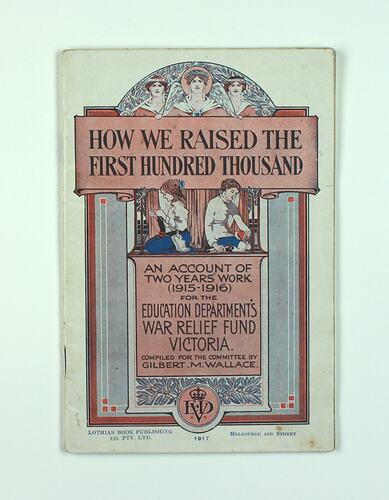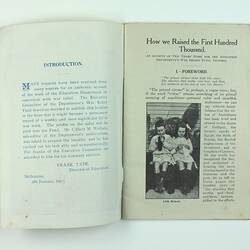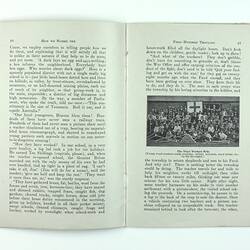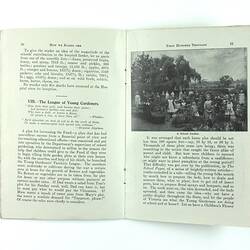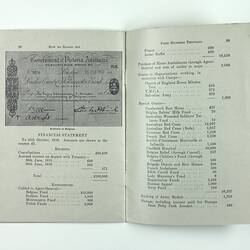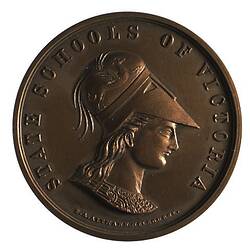Summary
32-page booklet entitled 'How We Raised the First Hundred Thousand', published by the Victorian Eduction Department in early 1917. It provides, through texts and illustrations, 'an account of two years' work for the Education Department's War Relief Fund, Victoria', including sections on 'The Call to Serve', 'The Beginnings of Organisation', 'A Central Depot', 'How the Little Schools Helped', 'How the City Schools Lent a Hand; 'Helping the Caulfield Military Hospital', 'The League of Young Gardeners', 'The Young Workers' Guild', 'Letters Inward and Outward', 'Auxiliary Forces', 'Debit and Credit' (with balance sheet) and 'What of the Future?'. A forward by Frank Tate, Victoria's first Director of Education, dated 9 January 1917, notes that the booklet will be sold with profits paid into the war relief fund ('Price 3D' printed on back cover).
The booklet provides a valuable summary of education-related fund-raising activities in Victoria during World War I. It indicates that total amount of money raised for the Victorian Education Department's Relief Fund to 31 December 1916 exceeded £149,000. About 350,000 'articles of comfort' were made or given by school children and sent abroad to that date.
At the outbreak of war, the Education Department of Victoria ran 2,174 'elementary' schools with 214,986 children enrolled. One-third of these schools had an average attendance of only 30 pupils. In addition, there were 19 'higher elementary' schools, 22 'junior technical' schools and colleges, and 24 'district high' schools, with a combined total of 3,895 enrollments. (Triolo, 2012) A regular 'School Paper', which children purchased for a penny, provided educational information and communications about the war, and how children could and did help the war effort. An 'Education Gazette' was used to communicate similarly to teachers.
World War I deeply effected the lives of Australian school children and their teachers. Teachers fought and died in disproportionately large numbers, and children went to great lengths to make handcrafts to send to soldiers, raise funds through growing vegetables, holding fetes and purchasing badges, and taking part in many other activites in support of the war effort.
Physical Description
32-page booklet with paper cover, printed in blue and red on white. Cover depicts two kneeling girls, one sewing, the other with a hammer, within a squared border topped with banner. Above the banner are three female figures (heads and shoulders), with left and right ones wearing garlands labelled 'JUSTICE' and 'PEACE'. At the base of the image is a crown surmounting 'EVD' for 'Education Department of Victoria'. The booklet includes extensive text, divided into sections. The booklet is illustrated wtih low-quality black and white photographs including a dour-looking 'send-off to Members of the Education Department, enlisted for the War, Melbourne, 10th Sept., 1914', boys with a cart-full of goods 'From the Depot to the Railway Station', a 'Bush School', a group of children who have made 'crutches, splints, bed-rests, ward tables, etc., by the thousand', soldiers at leisure and at Anzac Cove, 'Young Workers of a City School', a Caulfield Military Hospital ward and a march labelled 'The Return'. Two staples secure the booklet's spine.
More Information
-
Collecting Areas
-
Acquisition Information
Purchase
-
Date Made
-
Publisher
-
Place Named
No.11 Australian General Hospital (Caulfield Military Hospital)
-
Inscriptions
Printed on cover: 'HOW WE RAISED THE / FIRST HUNDRED THOUSAND / AN ACCOUNT OF / TWO YEARS' WORK / (1915-1916) / FOR THE / EDUCATION DEPARTMENT'S / WAR RELIEF FUND / VICTORIA. / COMPILED FOR THE COMMITTEE BY / GILBERT. M. WALLACE. / EVD / LOTHIAN BOOK PUBLISHING / CO. PYT. LTD. / 1917 / MELBOURNE AND SYDNEY'. Extensive text within booklet.
-
Classification
-
Category
-
Discipline
-
Type of item
-
Overall Dimensions
122 mm (Width), 2 mm (Depth), 182 mm (Height)
-
References
Rosalie Triolo, 2012. Our Schools and the War. North Melbourne, Australian Scholary Publishing Pty Ltd
-
Keywords
